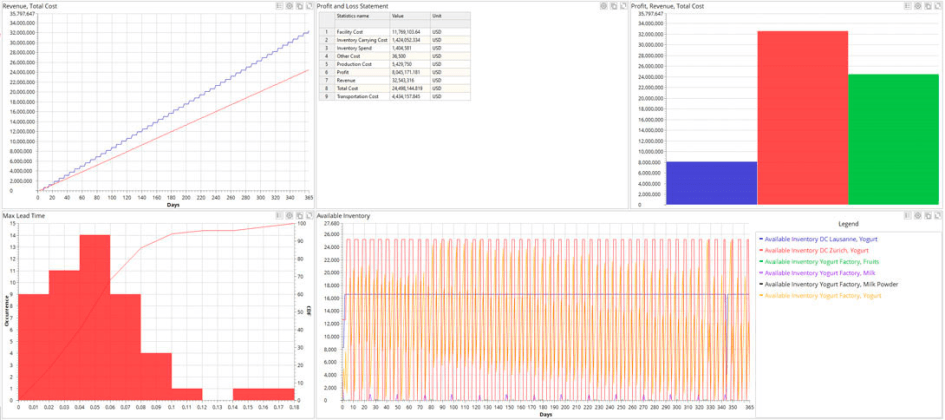
This article introduces the broad field of supply chain analytics and its main approaches, gives an example workflow for end-to-end supply chain analysis, and compares supply chain tool anyLogistix with traditional Excel-based analysis methods.
Supply chain analytics is an essential element of supply chain management. It helps organizations gather, assess, and extract value from the, nowadays immense, amounts of data related to the procurement, processing, and distribution of goods.
Of course, analytics isn’t a new discipline. Supply chain managers have been populating spreadsheets and sorting through report printouts for decades. However, that kind of analysis can be painfully slow and tedious because supply chains often include hundreds of different entities. And, thanks to modern data collection, the amount of information to process only keeps on growing.
Supply chain analytics can uncover opportunities for process improvements and draw attention to problems managers may have missed. Essentially, it helps identify risks, now and in the future, so that disruptions and their impact on the bottom line can be avoided. This ability to pinpoint existing supply chain risks and foresee future ones may be the most valuable benefit of analytics.
Overall, supply chain analytics can help an organization apply information from its operations and business environment to improve its processes and competitiveness. However, for it to work effectively supply chain managers should know what data to collect and how to use it.
For supply chain analytics there are three main approaches:
Descriptive analytics
What happened, where, and why? It analyzes past events based on internal and external systems, compares data from different periods, and identifies patterns. It investigates what might have caused past failure and success. Companies frequently use this type of analytics by tracking their everyday operations and analyzing reports.
What will happen and what should we do next? It uses historical data and transactional data to determine the probable future outcome of an event and how it would affect business. It extrapolates this from patterns found in the processed data to identify future risks and opportunities. To make accurate predictions, companies opt for simulation modeling.
Prescriptive analytics
What are my best outcomes and what do I need to do to make them real? Existing supply chain data can be used not only for forecasts, but also prescriptions on how to achieve the lowest costs or improve other metrics. Some of the techniques are machine learning and network optimization. For example, optimization compares a multitude of variants of a supply chain network's structure and operation rules and suggests the best ones in terms of the objective (e.g. costs).
Overall, prescriptive analytics helps businesses resolve problems and avert supply chain disruptions, test various scenarios using simulation, determine policies, and much more.
Supply chain analytics can help your company become a data-driven one. There are three main steps to getting started:
Basic level supply chain analytics tools take logistics data from your end-to-end operations and transform it into dashboards for easy visibility. More advanced analytics software goes beyond simply reporting by providing support for predictive and prescriptive analytics.
For most companies, supply chain analytics has traditionally been associated with looking at historical data in spreadsheets, for example in Excel. It is an approach that works, but eventually, companies using MS Excel run into its limitations because of the increasing complexity of real-world supply chains.
The more complex a supply chain, the more difficult and time-consuming it is to manage with spreadsheets alone. To gain visibility over your operations, you need a dynamic and agile tool that supports in-depth analytics – both predictive and prescriptive. For the tool to be truly effective, it should also be user-friendly and easily accessible to those involved in supply chain activities.

Flexible statistics & visualization in anyLogistix
Companies around the world use supply chain analytics tools, such as anyLogistix, for testing performance, developing ideas, analyzing risks, and creating plans based on insights. anyLogistix easily integrates with workflows by connecting with your databases. You can also use the software’s visual interface, dashboards, and various statistics to model operations and measure service levels, resource utilization, inventory dynamics, and more.
Integrating analytics into your supply chain can fuel its digital transformation. To learn more about the challenges you can face during this process, possible solutions, the tools that can aid you, and more, download our Supply Chain Digital Transformation white paper.